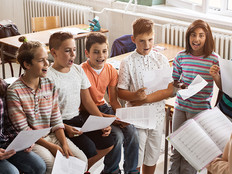Why Texting Should Be Part of Teaching
Ever heard of Teacher Text? It’s a moniker for the intentional use of text messaging for educational purposes. The increasing role of technology in the classroom affords new ways for schools to lessen the fear of handheld devices as a distraction and lean in to strategic ways to augment their use in learning environments.
The idea of looking at how teachers could make use of text in the classroom started as an experiment in an undergraduate psychology course at Texas’ Cisco College, where I previously taught. The aim was to examine ways texting could be leveraged in the academic space — beyond social interactions and campuswide announcements.
The use of apps that provide two-way communication open up the opportunity for K–12 programs to safely increase engagement and deepen learning.
The Possibilities
Teachers can ask students to create questions in class and then send them through a texting app as a review or practice for an upcoming test. Homework can be accomplished using a familiar device, in recognizable contexts, spaced out to strengthen learning and offered as a way to move the one-sided approach of evening homework to a more interactive experience.
Today, many — if not most — K–12 institutions use apps to disseminate one-way updates about school events and push information to students and parents. Often these communications duplicate content sent in school emails, such as dates for upcoming events, emergency or weather communications, and general information. Sometimes, schools and specific teachers also use push apps to provide reminders about homework and other pertinent class information.
But the intent of Teacher Text is to move beyond these one-way communications to an exchange of information.
The percentage of teachers who say they want to use technology in the classroom more than they do now*
SOURCE: Harris Interactive, “Pearson Student Mobile Device Survey 2013,” April 2013
The Results
For our research, the first implementation was in an undergraduate, face-to-face developmental psychology class of 32 students. We assigned 16 students to a control group, and 16 to an experimental group.
The students in the experimental group received four texts per week: an informative note about expectations for the week, such as readings, assignments, quizzes and the like; a text connecting the unit of study to current events that could include a link to news websites, blogs, articles or videos; a student-specific note based on ongoing work or effort; and last, a query to send a reply to the teacher with a question, comment or concern.
The students in the experimental Teacher Text group demonstrated higher scores on quizzes, papers, exams and the final exam than students in the control group, who received no texts. Other institutions have replicated the study, each demonstrating improvements in grades and learning outcomes.
Additionally, students reported that they spent more time on task because of the convenience of the information, interaction with their instructors and connection to the subject on a daily basis as part of their “real life.”
Digital natives — basically everyone in a K–12 classroom today — are comfortable using handheld devices to interact and communicate. Staying connected through one’s smartphone is an ambient part of communication habits today, and texting is the primary communication medium of 14- to 18-year-olds. The notion of merging the anytime and everywhere affordance of texting with other classroom communications makes sense.









